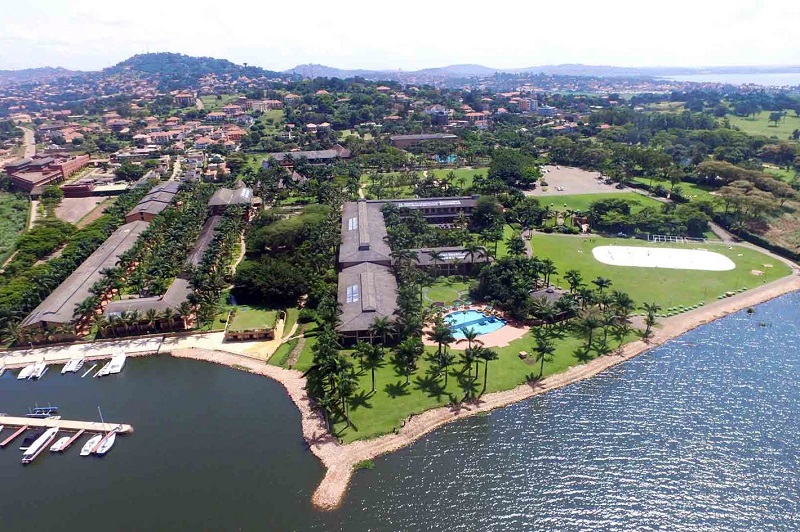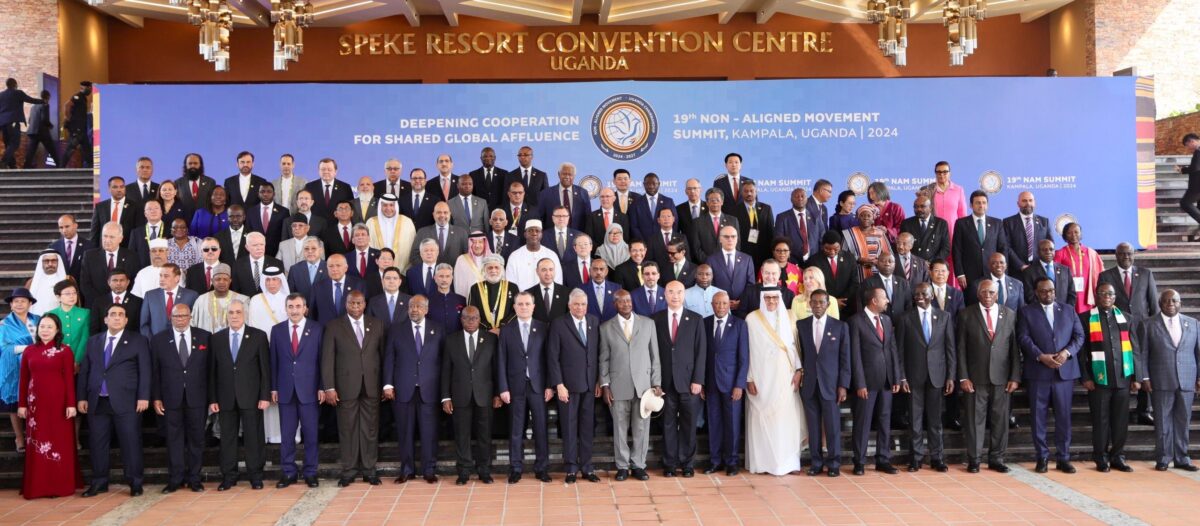Uganda has just successfully hosted the 19th Non-Aligned Movement (NAM) Summit and the Third South Summit of the G77 and China, at the 3,800 seater Speke Resort Convention Centre.
A joint venture of the Uganda Development Corporation (UDC), the investing arm of the Government of Uganda and the Ruparelia Group the facility also hosts a multipurpose hall, 12 high-end conference/breakaway meeting rooms and a floating restaurant that can host more than 900 guests.
Perhaps what makes it stand out even more, is that the convention centre was developed within an existing 105-acre luxury resort complex that already hosts the Speke Resort Munyonyo and Munyonyo Commonwealth Resort⏤ arguably some of Uganda’s best hospitality facilities.
Altogether, the Speke Resort Convention Centre, Speke Resort Munyonyo and Munyonyo Commonwealth Resort bring to Uganda’s hospitality sector 33 high-end breakouts/conference and meeting rooms; 5 ballrooms/ banquet halls; 3 indoor and 2 outdoor restaurants and bars, serving multiple cuisines; 2 VIP lounges and 8 outdoor function venues.
The resorts also have a combined 476 accommodation rooms, including 59 presidential suites.
Why is this important for Uganda?
From the time the project came to the limelight a number of innuendos and doubts have been made about this strategic development. Some have even attempted to label it as a political project of the President, given that one of the first big conventions, it will host, is the December 2023 Non-Aligned Movement (NAM) Summit.
Just a year ago, Uganda relaunched its destination brand, inviting the whole world, to come and Explore Uganda, the Pearl of Africa⏤ richly and uniquely blessed with a wide range of natural, cultural, historical and human attractions, that continue to deliver lifetime experiences to domestic, regional and international visitors alike. The new destination brand, sits within a larger strategy to diversify Uganda’s tourism from being predominantly wildlife, to also include other high-potential tourism sectors such as cultural, Meetings, Incentives, Conferences & Exhibitions (MICE) tourism.

By doing so, Uganda hopes to increase the volume of tourist arrivals from 1.5 million in 2019 and length of stay to 2.1 million in 2025 and the length of stay from 8 nights to 11 nights. Doing so, Uganda Tourism Board (UTB) believes, will increase the inbound tourism revenues per visitor from USD1,052 to USD1,500. This will increase tourism’s contribution to total employment from 6.3% to 8.5% as well as increase the contribution of tourism to GDP and several other benefits.
Meetings, Incentives, Conferences & Exhibitions (MICE) tourism⏤ the emerging gold in tourism
One of Uganda’s biggest challenges is the nature and structure of our tourism market. An industry analysis of the “purpose of the visit” shows that 35% of our inbound visitors, come to visit friends and family and therefore are more likely to not spend much on accommodation and food which are by far the biggest components of tourist expenditure. Only 22.4% come in for business meetings and or professional services and only 17.9% for leisure/recreation and holiday.
Kenya, by comparison, has nearly 40% of its inbound visitors for holidays/leisure and nearly another 30% destined for business meetings. These are the two most lucrative and high-spending and long-staying tourist segments.
As Uganda seeks to diversify its tourism experience, MICE tourism represents a great complement to our rich natural attractions.
The World Travel & Tourism Council (WTTC) Travel & Tourism Economic Impact 2022 Report reported that business travel⏤ a catalyst for growth across the wider travel & tourism sector, reached US$ 1.3 trillion, accounting for 21% of total travel & tourism spending. it also reported that business travel grew by 30.9% in 2021 and was to grow 41.1% in 2022 and thereafter would grow by an average of 5.5% between 2022 and 2032.
MICE tourism, the WTTC said, “has the potential to bring large quantities of high-spending visitors to a destination, thereby significantly increasing tourism revenues”. MICE tourism can also extend the tourism season, noting that the surge in ‘workation holidays’ enabled by remote and flexible working offers new opportunities to travel providers and destinations.
“Given that business, travel is vital for many sectors of the global economy, it is important that all stakeholders join forces to find solutions to aid its recovery,” the report noted.
It is in light of this that I wish to applaud the government’s efforts, most especially, the efforts of President Yoweri Kaguta Museveni who for a very long time has always known and supported Uganda’s efforts to attract and host big international meetings.
Anyone attempting to politicise such opportunities for Uganda to showcase itself surely doesn’t appreciate the significance of MICE tourism.
Needless to mention, MICE tourism is largely reliant on a destination’s portfolio of world-class tourism infrastructure for meetings such as – fully equipped meeting rooms and supporting amenities such as accommodation, banqueting and dining facilities, as well as ease of accessibility and of course security.

The Uganda Hotel Owners Association (UHOA) estimates that our accommodation facilities offer about 487,000 beds and 410,000 rooms. By comparison, Kenya has about 800,000 rooms combined. For Uganda to become a force in the MICE market, it is estimated that we need about 1,000,000 rooms countrywide. Uganda’s low supply of tourism and hospitality infrastructure is partly blamed on the low presence of international branded hotel operators. As of June 2019, as few as 4 international hotel chains were operating in Uganda i.e. Marriott International Group (Sheraton Hotel and Protea Hotel brands); Louvre Hotels Group (Golden Tulip Canaan brand); and Hilton Garden Inn and Latitude 0˚. Since then, a few other brands have shown interest such as Onomo Hotels, and Four Points by Sheraton. This is complemented by other regional brands such as Serena Hotels.
By comparison, Kenya, according to Knight Frank, has over 68 branded chains of hotels.
To fill this gap, homegrown hospitality brands such as the Speke Group, Marasa Africa, Geo Lodges, WildPlaces Africa, Uganda Lodges etc have all emerged and are ably competing with international brands.
The development of tourism infrastructure- just like transport or energy infrastructure, needs significant government involvement because tourism infrastructure, just like other social-economic infrastructure benefits the whole country in several ways.
Lest we forget, why we need to support our tourism sector, in 2019, inbound tourism generated UGX 4.6 trillion while domestic tourism expenditure was valued at UGX3 trillion. The direct contribution of tourism to GDP (3.64 %) is comparable with Livestock (3.6 %), forestry (4.0 %) and education (4.3 %) and much higher than transportation and storage (3.4 %), human health and social work activities (3.2 %), financial and insurance activities (2.7 %) among others. In 2019, tourism’s direct contribution to employment was estimated at 14.7 % of total employment meaning that at least 1 in 10 persons employed is directly employed in tourism. The Tourism sector directly employed 1,559,147 persons in FY 2016/17 out of which 739,573 persons (47.4 %) were employees while 819,574 persons (52.6 %) were self-employed.
